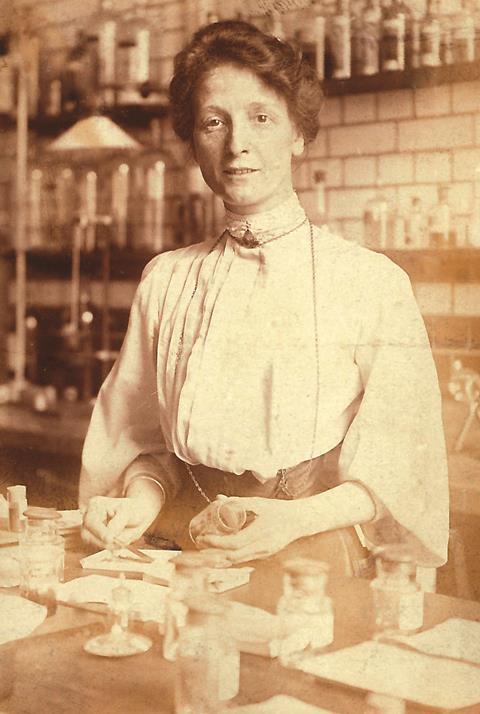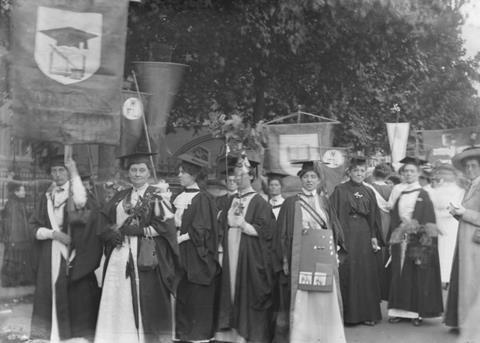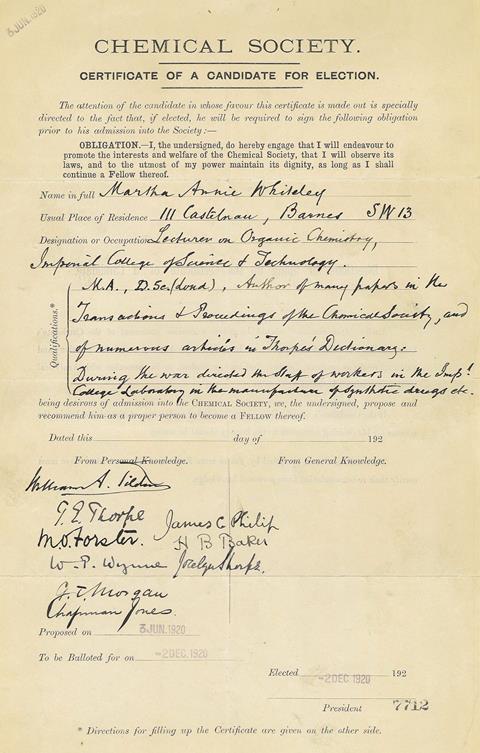Rachel Brazil looks back at women’s fight for professional equality in chemistry

December 2018 marks the centenary of the first UK general election in which women could vote – albeit only those over the age of 30 who owned property. But it would be a further two years before women gained entry to the Chemical Society, the main body representing chemists at that time and a forerunner society of today’s RSC. As with the women’s suffrage movement, the struggle for professional equality in chemistry was hard fought and quickly forgotten. Most instrumental in that fight were two chemists, Ida Smedley and Martha Whiteley. Today we talk about glass ceilings, but these women had doors slammed in their faces. They kept knocking.
The women’s suffrage movement began in the UK in the late 19th century and saw itself representing modernity and hence pro-science, according to historian Patricia Fara at the University of Cambridge in the UK. In her 2018 book, A Lab of One’s Own,1 Fara tells the fascinating stories of the many women who carved out scientific careers for themselves during and after the first world war. For these and other professional women, gaining the vote in 1918 may not have been as important as gaining professional acceptance and financial independence. ‘What really mattered to them in their own lives was that they got equal status and equal pay for doing the same work, and the opportunity to be promoted which was often denied,’ says Fara.
Excluding women from science
Justification for keeping them out of science was often related to its effect on their roles as women, rather than their competence as scientists. One of the most laughable ideas (surely even then) was put forward by Edward Clarke, a professor of medicine at Harvard University in the US. He argued that if women exercised their brains, their ovaries would shrivel. The key opponent to women’s membership of the Chemical Society, Henry Armstrong, believed women chemists should ‘be withdrawn from the temptation to become absorbed in the work, for fear of sacrificing their womanhood’. Instead, he said, they should become the mothers of future chemists.2

‘It varied enormously from individual to individual, and people like the Braggs, for example, were incredibly supportive of women and they gathered a huge team around them,’ says Fara, but adds their motives may not have not been totally altruistic ‘By definition, the women who managed to get to a research level were very clever and very determined – but also they were paid two-thirds of what men were paid for doing the same work.’ Within science, chemistry attracted more women than other disciplines. ‘The idea was that chemistry is a bit like cooking, you are mixing things together and as long as you follow the recipe you are going to turn up with the right end product, so there was less bias in chemistry,’ says Fara.
The situation for women in professional bodies was also varied, but in the early 20th century most still excluded women. One exception was the Royal Institute of Chemistry which oversaw consulting and analytical chemists. It ‘accidentally’ allowed women to join in 1892, when an analytical chemist, Emily Lloyd, sat and passed the qualifying exam under the name E. Lloyd.
The first world war was a big milestone for women in science. Women were able to take previously inaccessible positions, such as May Leslie, who had studied with Marie Curie and was put in charge of a wartime research project into explosives – although she lost her position as ‘chemist in charge of laboratory’ after the war.
Pioneering women
Smedley and Whiteley embarked on their chemistry careers from very different backgrounds. Smedley (1877–1944) came from a comfortable middle class family and studied at the women-only Newnham College, Cambridge, which had its own laboratory. She was appointed the first female chemistry lecturer at the University of Manchester in 1906 and in 1910 moved to the Lister Institute of Preventative Medicine in London. Unlike many, she continued her career after her marriage and having children and, as well as her renowned work on fatty acids, she formed the Federation of University Women, of which she was president from 1929–1935.

Whiteley (1866–1956) on the other hand, was from a less privileged background and was educated at Royal Holloway College in London. Without the ability to finance a research career she moved into teaching for 11 years, but managed to carry out research as well. She eventually became an assistant professor at Imperial College and during the first world war assembled a team of women chemists who synthesized the anaesthetic β-eucaine as well as carrying out research on mustard gases (which she reportedly tested on herself, causing injury). She was eventually the first women elected to the council of the Chemical Society.
Women like Smedley and Whiteley were undoubtedly supporters of the suffrage movement – although probably not suffragettes, the group who believed in ‘militant’ tactics such as property damage and hunger strikes. ‘They were very active but they kept a fairly low profile,’ says Geoff Rayner-Canham, from Memorial University of Newfoundland in Canada, the co-author of several historical studies of women in chemistry. ‘They were more [focused] on pushing for women’s education as a very specific goal.’

Education was always an important concern for the suffrage movement. ‘Whenever the graduates marched in suffrage processions in their academic dress, they got huge support and cheers from the crowd. Even women who had no opportunity to go to university themselves (the vast majority of people didn’t) were thrilled that some women were able to do it,’ says Fara. In the June 1907 march of over 10,000 to the Royal Albert Hall, banners were held showing professional women including scientists like Mary Somerville, Caroline Herschel, Florence Nightingale and Marie Curie.
But the women chemists engaged in battling for professional equality felt the need to keep away from politics. ‘Some of them understandably wanted to protect their hard-won positions,’ says Fara. This is seen in a 1909 letter to Chemical News written by the 31 women chemists seeking membership of the Chemical Society. After accusations that they were associated with the suffrage movement, the letter argued that their interests were in chemistry alone. ‘There is obviously a sense that in order to keep widespread support they couldn’t be labelled radical feminists and suffragists,’ says Rayner-Canham.
Women in the US
The situation for women chemists in the US was very similar, although ironically, it was a female chemist who initiated the American Chemical Society’s foundation. Rachel Bodley (1831–1888) was born in Cincinnati, the daughter of a carpenter and teacher. She studied chemistry and physics at the Polytechnic College of Pennsylvania and in 1865 she became the first female professor of chemistry at a medical school, the Woman’s Medical College of Pennsylvania.
The entertainment included comic toasts and songs aimed at belittling women
In 1874, to mark the centenary of the year Joseph Priestly discovered oxygen, she proposed a celebratory meeting and it was as a result of this that the new society was formed. Bodley was elected a charter member and a vice-president. But lest this sound rosy, this seems more the exception than the rule. At the meeting itself, the three women chemists attending were not included in the official group photo.3
Bodley’s involvement with the society came to an end in 1880 after an event that was known as The Misogynist Dinner of the American Chemical Society. Organised by Henry Morton, a professor at Philadelphia Dental College, and Sterry Hunt of MIT, the all-male dinner was held in Boston on 27 August, during a society meeting (the episode was not mentioned in the formal meeting report, which included papers co-authored by two women). The entertainment included comic toasts and songs aimed at belittling women, as well as marriage and its effect on men. The tone seemed to indicate a feeling that science should be a monastic pursuit, with the absence of women in any capacity, let alone as fellow chemists. The dinner and sentiments expressed may not have been rare, but on this occasion a stenographer recorded the event and Morton chose to have a transcript distributed to members.
Bodley resigned and there were no further female members until 1891 when Rachel Lloyd from the University of Nebraska was elected a member. She was the first American woman to earn a chemistry doctorate in 1887, although she had to go to Switzerland to do so. She was also the first woman to publish research in a major American chemical journal in 1881. It was her husband who introduced to chemistry – he had his own home laboratory. But she was widowed at 26 and eventually become a chemistry teacher. She continued studying at Harvard University’s summer sessions (women were not permitted to enrol as full students) and at 48 gained her PhD from the University of Zurich – a rare exception in allowing women students.4
The struggle for fellowship
The first attempt to allow women to become fellows of the Chemical Society was by University College London chemist William Ramsay in 1892. Ramsay, a strong proponent of women chemists, proposed a change to the society’s by-laws but he was defeated by a margin of eight to seven. The issue did not come up again until 1904 when a fellowship for Marie Curie was agreed, but only as a foreign fellow. At this point, 19 women including Smedley and Whiteley requested membership. The council agreed in principle, but an extraordinary general meeting was required and only 45 of the 2700 members showed up, 23 of whom voted against their admission.

By 1908, 28 women petitioned for membership, even writing to Nature and having a petition signed by 312 distinguished members urging for change. Things were looking good as the support was there, but at the final council meeting, Armstrong proposed women only be given a special subscriber status. This ‘compromise’ was favoured 15 to seven – perhaps in fear that Armstrong intended to take legal action against the society. The disappointment must have been crushing for the women involved and they urged others not to take up the insulting new membership category, and only 11 women ever did.
Change did not come until 1919 when eventually the society agreed women could become fellows. This was probably spurred on by the 1919 Sex Disqualification (Removal) Act, which made it illegal to discriminate against women on grounds of marriage and lifted other restrictions. In 1920, 21 women were admitted to the Chemical Society as fellows, including Smedley and Whiteley. Sadly, three of the original 19 did not live to see their eventual victory.
Equality achieved?
Of course, gaining access to professional groups was only a small breakthrough and in the years after the first world war opportunities in chemistry declined for women. In industry they were seen as a disposable workforce and their competence increasingly questioned as fears of male unemployment grew.3
The idea of professional bodies as gentlemen’s clubs also did not disappear. In her history of women scientists in America, Margaret Rossiter recounts that in 1927 the Colombia University chapter of the ACS was still excluding women by holding meetings at men-only dining clubs.3 Presumably facing similar attitudes, Whiteley and Smedley set up their own women’s chemists dining club in 1925, which met 3 times a year, although it seemed to have disappeared by the 1950s.
Progress can be slow. In the UK women had to wait until 1928 for fully equalised voting rights and the first statue commemorating a suffrage campaigner, Millicent Fawcett, only made it to Parliament Square this year. In chemistry, women’s struggle for professional equality continues. A recent study of author gender balance showed that only 20% of chemistry papers have female principal investigators. With the current rate of change the number will not reach parity with men for another 50 years.5 Would Smedley and Whiteley be surprised at the situation a century on? ‘Suffragists could see what they were fighting against, but modern discrimination is elusive, insidious and stubbornly hard to eradicate,’ Fara says.
Rachel Brazil is a science writer based in London, UK
References
1 P Fara, A Lab of One’s Own: Science and Suffrage in the First World War, Oxford University Press, 2018
2 M F Rayner-Canham and G W Rayner-Canham, Bull. Hist. Chem., 2003, 28, 2 (http://bit.ly/2NwG3gY)
3 M W Rossiter, Women Scientists in America: Struggles and Strategies to 1940, Johns Hopkins University Press, 1984
4 Rachel Lloyd, Pioneering Woman in Chemistry, ACS National Historic Chemical Landmark http://bit.ly/2zQKBeE
5 L Holman, D Stuart-Fox and C E Hauser, PLoS Biol., 2018, 16, e2004956 (DOI: 10.1371/journal.pbio.2004956)












No comments yet